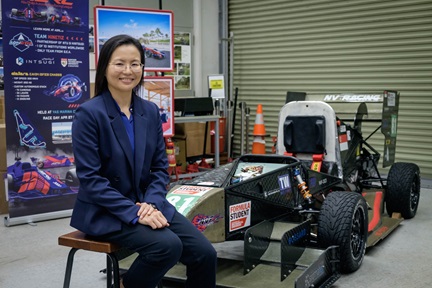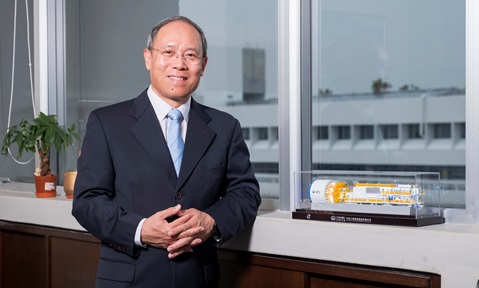Technology in transit: transport gets greener, smarter and swifter
Scientists at NTU are making a sustainable push for air, land and sea transport.
.jpg?sfvrsn=b5366f51_3)
From commercial flights to sea freight and daily train commutes, it has become more convenient to move people and goods from one place to another. However, modern-day transport contributes to over a third of global carbon dioxide emissions. It also accounts for nearly 30% of the world’s energy consumption.
To reach net zero, nations are finding ways to decarbonise transport. At NTU, various research groups are spearheading efforts to make our transport systems smarter and more sustainable.
GREENER AT SEA
As the backbone of international trade, the maritime sector is a billion-dollar industry on a continuous growth uptick. Similarly growing is its carbon footprint: maritime greenhouse gas emissions rose by 20% in the last decade, accounting for 3% of global emissions. In countries like Singapore where maritime is crucial for the economy, decarbonisation is a priority.
“For us to achieve environmental sustainability and to reinforce Singapore’s position as a leader in maritime innovation, it is essential to integrate green energy solutions into the maritime industry,” shares Dr Imran Ibrahim from NTU’s Maritime Energy and Sustainable Development Centre of Excellence (MESD CoE), a research centre jointly funded by the University and the Singapore Maritime Institute to develop solutions for greener ports and shipping.
As part of Singapore’s efforts in maritime decarbonisation, MESD CoE is collaborating with the Maritime and Port Authority of Singapore to transition new vessels used only within the country’s port to full-electric propulsion and netzero fuels. One attractive carbon-free fuel is ammonia, which could cut shipping greenhouse gas emissions by up to 61%.
However, ammonia is toxic and needs to be handled with care. To facilitate the safe use of the fuel, Dr Liu Ming from MESD CoE is improving the industry’s understanding of how ammonia spreads and disperses in the air when released, as well as proposing mitigation measures against accidental ammonia release.
Through theoretical modelling and simulations, Dr Liu’s team has identified different patterns of how ammonia disperses in the air. These insights can guide the industry in choosing the right mitigation measure based on different scenarios.
Moving forward, the team has planned field experiments to validate their findings and deploy proposed mitigation technologies. “The outcomes can be directly applied to create safety features at future ammonia bunkering facilities in Singapore,” states Dr Liu.
SMARTER IN AIR
Aviation is one of the fastest growing contributors of greenhouse gases as aircraft burn large amounts of fossil fuel. A considerable proportion of fuel – up to 15% – is consumed during aircraft taxi-out (before take-off) and taxi-in (after landing) phases. In certain high-congestion scenarios, this figure can be higher.
Researchers at NTU’s Air Traffic Management Research Institute (ATMRI) are pioneering advancements in air traffic management to reduce taxiing delays and the corresponding fuel usage.
“ATMRI’s research integrates advanced technologies such as artificial intelligence (AI), machine learning and data analytics into air traffic management systems,” says ATMRI’s Deputy Director, Assoc Prof Sameer Alam. A collaboration between NTU and the Civil Aviation Authority of Singapore, ATMRI is notably the first institute outside Europe to participate in the Single European Sky ATM Research 3 Joint Undertaking initiative that seeks to transform Europe’s air traffic management using digital technologies.
One groundbreaking innovation from ATMRI is the Intelligent Departure Metering Advisory Tool (I-MATE), an AI-driven assistant designed to enhance the departure metering process for air traffic controllers. Departure metering involves scheduling aircraft to wait at the gates rather than on runways before takeoff, thereby reducing runway congestion and fuel wastage due to aircraft idling on the airside.
Traditionally, air traffic controllers manually coordinate departure timings, balancing the need to avoid taxi-out delays with the goal of optimising runway traffic. “When runway traffic forecasts are uncertain, controllers find it challenging to consider them effectively when scheduling aircraft departures,” notes Dr Hasnain Ali from ATMRI.
While currently available modelbased departure metering tools offer some assistance, they often oversimplify the complexities of real-world air traffic management. In contrast, I-MATE employs deep reinforcement learning, a sophisticated AI technique that allows it to learn iteratively from simulated experience and adapt its strategy to dynamic and uncertain situations.
“We have conducted validation experiments to assess the efficiency and acceptability of I-MATE in assisting air traffic controllers to manage airside traffic in a realistic simulated environment. The results revealed a significant reduction in taxiing delays (25.6%), alongside increased compliance with I-MATE recommendations.
This may translate to improved efficiency, cost savings for airlines and an enhanced passenger experience,” explains Dr Hasnain. European data suggests that reducing taxiing delay by one minute could save about €62 (S$90.82) per commercial flight, including expenditure from burning fuel and reactionary delays. The decrease in fuel consumption would also result in a proportional drop in related emissions.
SWIFTER ON LAND
Electric rail networks, such as the Mass Rapid Transit (MRT) system in Singapore, are more environmentally friendly than fossil fuel vehicles as they produce less carbon emissions. For this major transport system that ferries millions of passengers daily, preventive track maintenance is integral to ensure smooth operations.
“Current MRT track maintenance, however, relies on regular visual inspections conducted by trained personnel, who use camera-based systems designed to detect cracks, wear and faults. These methods mean that issues are only identified after they have occurred,” says Prof Yang Yaowen from the University’s School of Civil and Environmental Engineering (CEE).
Together with Asst Prof Fu Yuguang from CEE and Prof Gao Cong from NTU’s College of Computing and Data Science, Prof Yang is piloting an AI-based smart sensing system that gives early warning of potential problems. By attaching fibre optic cables along stretches of tracks and installing small accelerometers at strategic points, vibration signals from passing trains can be captured. The vibration data is analysed in real-time by a sophisticated AI model that picks up anomalies on the tracks or the train.
Maintenance teams can then be speedily deployed to pinpointed locations. “Early detection of problems and intervention will help prevent delays and reduce the likelihood of unexpected service interruptions. For commuters, this means a more reliable and efficient MRT with fewer breakdowns,” highlights Prof Yang, emphasising the importance of proactive maintenance.
The article appeared first in NTU's research and innovation magazine Pushing Frontiers (issue #24, October 2024).



.tmb-listing.jpg?Culture=en&sfvrsn=29c7e020_1)
.tmb-listing.jpg?Culture=en&sfvrsn=55153609_1)


